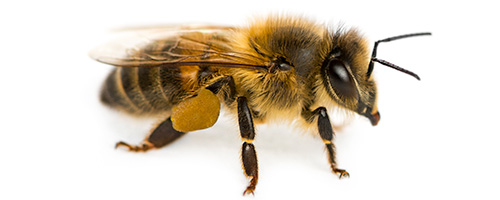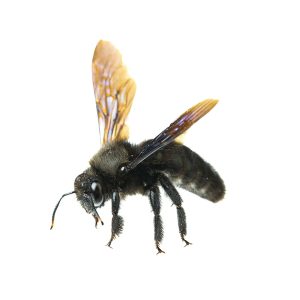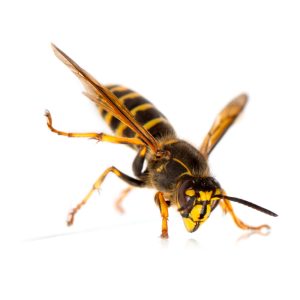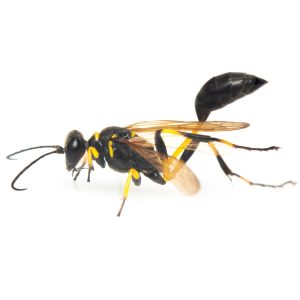Bee & Wasp Control and Extermination
Contact or Schedule Service

Bee & Wasp Control and Extermination
Maximum Pest Management provides expert bee and wasp control, eliminating the stinging insects and whenever possible removing their nests. Not only are wasp and bee stings painful, for individuals who are allergic, they can cause severe reactions resulting in expensive emergency room visits.
If wasps, bees, hornets, yellow jackets or other stinging pests are making their nests around your home or business, we’ll provide safe, effective solutions. We have more than 20 years of experience identifying and controlling all types of stinging insects. We’re a local, family-owned bee and wasp control company in Wichita and we provide services to homes and businesses in the surrounding communities.
We provide stinging pest control services with no contracts so you can start, stop or change treatments at your convenience.

Signs of Bee and Wasp Infestation
If you notice bees, wasps, hornets or other stinging pests frequently flying around, that’s a good sign to have your property checked for infestation. And, if you notice a large wasps’ nest, beehive, or what looks like large ant hills in your yard, it’s best to call a professional pest control company for an inspection.
How We Treat for Bees and Wasps
Bee and wasp control methods depend on the type of insect(s) involved, and may include physical removal, traps and more. Maximum Pest Management begins with a free inspection to locate hives or nests and determine the level of infestation. Then, we’ll recommend a contract-free custom treatment plan so you can schedule services at your convenience. Your technician will also provide you with recommendations for limiting food and housing sources for stinging pests.
Ways to Prevent Bees and Wasps Around the House
As with other pests, sealing off cracks and gaps that can provide access to the attic, crawlspace, basement, under the deck, etc., will keep stinging insects out of your home.
- When planting flower beds, potted plants, trees and shrubs, choose plants that will be less likely to attract bees, wasps and other stinging pests. Some plants even repel them.
- When eating outdoors, keep sweet food and drinks covered as much as possible. Consider placing traps for stinging insects to keep them from getting near you and your guests.
- Reducing standing water around your home will help prevent mosquitoes and the insects on which stinging pests feed.
- Many stinging pests reuse old nests year after year, so it’s a good idea to remove abandoned nests before they can be reclaimed.
- Unfinished wood is a favorite source of nest building materials for many stinging pests, so make sure fences, furniture, decks, planter boxes and other outdoor wood structures are painted or sealed. Avoid storing firewood near the house.
Reviews for Maximum Pest Management
Signs of Bee and Wasp Infestation +
If you notice bees, wasps, hornets or other stinging pests frequently flying around, that’s a good sign to have your property checked for infestation. And, if you notice a large wasps’ nest, beehive, or what looks like large ant hills in your yard, it’s best to call a professional pest control company for an inspection.
How We Treat for Bees and Wasps +
Bee and wasp control methods depend on the type of insect(s) involved, and may include physical removal, traps and more. Maximum Pest Management begins with a free inspection to locate hives or nests and determine the level of infestation. Then, we’ll recommend a contract-free custom treatment plan so you can schedule services at your convenience. Your technician will also provide you with recommendations for limiting food and housing sources for stinging pests.
Ways to Prevent Bees and Wasps Around the House +
As with other pests, sealing off cracks and gaps that can provide access to the attic, crawlspace, basement, under the deck, etc., will keep stinging insects out of your home.
- When planting flower beds, potted plants, trees and shrubs, choose plants that will be less likely to attract bees, wasps and other stinging pests. Some plants even repel them.
- When eating outdoors, keep sweet food and drinks covered as much as possible. Consider placing traps for stinging insects to keep them from getting near you and your guests.
- Reducing standing water around your home will help prevent mosquitoes and the insects on which stinging pests feed.
- Many stinging pests reuse old nests year after year, so it’s a good idea to remove abandoned nests before they can be reclaimed.
- Unfinished wood is a favorite source of nest building materials for many stinging pests, so make sure fences, furniture, decks, planter boxes and other outdoor wood structures are painted or sealed. Avoid storing firewood near the house.
Common Bees and Wasps Native to Kansas

Carpenter Bees
The carpenter bee is distinctive because of its large body with a shiny black abdomen.
Unlike bumblebees and honeybees, carpenter bees don’t live in colonies.
Although they can’t sting, male carpenter bees are territorial and like to hover near the entrances of their galleries to chase away potential predators.
Females, on the other hand, do have a potent sting.
Although they don’t usually cause as much damage as termites, carpenter bees often burrow into the dry exposed wood of siding, fascia boards, eaves, rafters, decks, telephone poles, fence posts, and bridges.
They typically do not excavate holes in wood that has been pressure-treated or painted.
The female carpenter bee excavates a series of long tunnels with branched chambers known as galleries, which are where she lays her eggs.
They often nest in the same piece of wood each year, digging new tunnels or making the old ones larger and causing both cosmetic and structural damage.

Hornets & Yellow Jackets
Hornets and yellow jackets are both types of wasps. Here in the U.S., we only have one true hornet species: European hornets, also known as giant hornets. These stinging insects are about an inch long and reddish-brown in color with yellow abdomens.
They like to nest in structure voids inside walls, in attics and inside hollow spaces of trees. Hornets often defend their colonies aggressively, which causes problems because they typically nest near people.
Yellow jackets are small wasps with black and yellow bodies. They have long wings that fold behind them, and they’re thinner at the top of their abdomen than bumble bees.
Yellow jackets can actually be helpful, since they’re pollinators and they eat harmful pests, flies and beetle grubs. They often make their nests on the ground, such as at the base of a tree trunk, under a porch, or even in a crack in the sidewalk. Yellow jacket colonies can also be found in bushes, low branches or at the corners of homes and other structures.
You may have experienced yellow jackets hovering around the food and drinks at a picnic, because they like to scavenge sugary food, leftovers in trash cans, and ripe fruit on the vine.
Although they will aggressively defend their colonies, yellow jackets don’t usually sting without being provoked. When they do sting, it’s quite painful and their stingers have smaller barbs than honeybees, allowing them to sting over and over.

Paper Wasps & Mud Daubers
Paper wasps are actually a group of wasp species notable for building nests made from chewed up vegetation and dead wood. These nests are often built under eaves or decks, and even in playground equipment.
Paper wasp nests are distinctive because they look like a grouping of small paper tubes hanging upside down from a single stalk.
Paper wasps can range from half and inch to one-and-a-half inches long, and they may appear orange, dark red, reddish brown, or even have yellow and red stripes. Unlike bees, their bodies are smooth instead of fuzzy.
Depending upon the species, some of these wasps can be particularly aggressive.
Mud daubers are a large wasp species measuring up to one inch long. Their bodies are typically black or dark blue and may look metallic.
It’s common to see mud daubers hovering around their nests or near puddles during the late spring and summer as they gather mud for their nests.
They’re solitary creatures that build their nests from mud attached to walls or ceilings of buildings, among other places.
Mud daubers feed on spiders, so controlling spiders around the home will make it a less inviting environment for these wasps.

Digger Wasps & Cicada Killers
Cicada killers are also known as sand hornets, although they’re not actually true hornets; in reality, they’re wasps that burrow into the ground. You may also hear them referred to as cicada hawks or ground hornets.
Often mistaken for yellow jackets, cicada killers can be grow up to two inches in length and have red and block backs with yellow stripes on their abdomens.
Although they are beneficial insects in that they kill cicadas, their burrows can be quite extensive and damage lawns. Cicada killer nests look like small holes and grainy piles of soil. They’re typically found in loose, dry soil and run about 10 inches deep.
Digger wasps are another type of beneficial pest because they feed on grub worms and insects that harm grass. Their bodies are blue-black or gold and black and about one inch long.
The digger wasp got its name from the nest that the female burrows into the ground. These nests look similar to ant hills but with openings that are about 3 inches across, which results in damage to lawns and grass.
Although female digger wasps rarely sting and males don’t have stingers, males will swarm and dive at predators or other threats.

Carpenter Bees+
The carpenter bee is distinctive because of its large body with a shiny black abdomen.
Unlike bumblebees and honeybees, carpenter bees don’t live in colonies.
Although they can’t sting, male carpenter bees are territorial and like to hover near the entrances of their galleries to chase away potential predators.
Females, on the other hand, do have a potent sting.
Although they don’t usually cause as much damage as termites, carpenter bees often burrow into the dry exposed wood of siding, fascia boards, eaves, rafters, decks, telephone poles, fence posts, and bridges.
They typically do not excavate holes in wood that has been pressure-treated or painted.
The female carpenter bee excavates a series of long tunnels with branched chambers known as galleries, which are where she lays her eggs.
They often nest in the same piece of wood each year, digging new tunnels or making the old ones larger and causing both cosmetic and structural damage.

Hornets & Yellow Jackets+
Hornets and yellow jackets are both types of wasps. Here in the U.S., we only have one true hornet species: European hornets, also known as giant hornets. These stinging insects are about an inch long and reddish-brown in color with yellow abdomens.
They like to nest in structure voids inside walls, in attics and inside hollow spaces of trees. Hornets often defend their colonies aggressively, which causes problems because they typically nest near people.
Yellow jackets are small wasps with black and yellow bodies. They have long wings that fold behind them, and they’re thinner at the top of their abdomen than bumble bees.
Yellow jackets can actually be helpful, since they’re pollinators and they eat harmful pests, flies and beetle grubs. They often make their nests on the ground, such as at the base of a tree trunk, under a porch, or even in a crack in the sidewalk. Yellow jacket colonies can also be found in bushes, low branches or at the corners of homes and other structures.
You may have experienced yellow jackets hovering around the food and drinks at a picnic, because they like to scavenge sugary food, leftovers in trash cans, and ripe fruit on the vine.
Although they will aggressively defend their colonies, yellow jackets don’t usually sting without being provoked. When they do sting, it’s quite painful and their stingers have smaller barbs than honeybees, allowing them to sting over and over.

Paper Wasps & Mud Daubers+
Paper wasps are actually a group of wasp species notable for building nests made from chewed up vegetation and dead wood. These nests are often built under eaves or decks, and even in playground equipment.
Paper wasp nests are distinctive because they look like a grouping of small paper tubes hanging upside down from a single stalk.
Paper wasps can range from half and inch to one-and-a-half inches long, and they may appear orange, dark red, reddish brown, or even have yellow and red stripes. Unlike bees, their bodies are smooth instead of fuzzy.
Depending upon the species, some of these wasps can be particularly aggressive.
Mud daubers are a large wasp species measuring up to one inch long. Their bodies are typically black or dark blue and may look metallic.
It’s common to see mud daubers hovering around their nests or near puddles during the late spring and summer as they gather mud for their nests.
They’re solitary creatures that build their nests from mud attached to walls or ceilings of buildings, among other places.
Mud daubers feed on spiders, so controlling spiders around the home will make it a less inviting environment for these wasps.

Digger Wasps & Cicada Killers+
Cicada killers are also known as sand hornets, although they’re not actually true hornets; in reality, they’re wasps that burrow into the ground. You may also hear them referred to as cicada hawks or ground hornets.
Often mistaken for yellow jackets, cicada killers can be grow up to two inches in length and have red and block backs with yellow stripes on their abdomens.
Although they are beneficial insects in that they kill cicadas, their burrows can be quite extensive and damage lawns. Cicada killer nests look like small holes and grainy piles of soil. They’re typically found in loose, dry soil and run about 10 inches deep.
Digger wasps are another type of beneficial pest because they feed on grub worms and insects that harm grass. Their bodies are blue-black or gold and black and about one inch long.
The digger wasp got its name from the nest that the female burrows into the ground. These nests look similar to ant hills but with openings that are about 3 inches across, which results in damage to lawns and grass.
Although female digger wasps rarely sting and males don’t have stingers, males will swarm and dive at predators or other threats.
